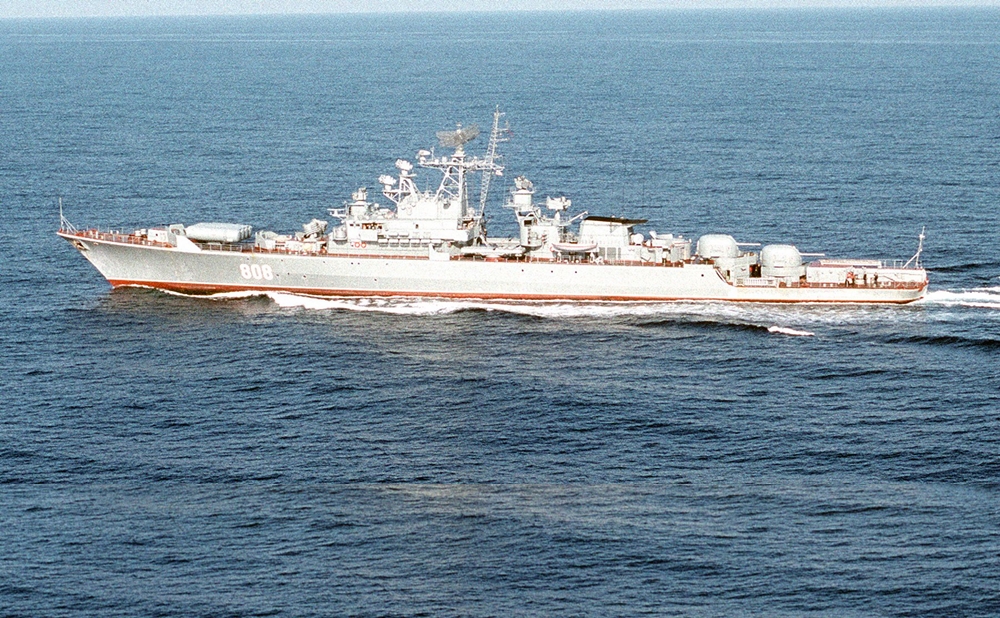RUSSIA MONITOR
Date: 27 March 2018
Russia Strengthens the Mediterranean Squadron
A squadron of the Russian fleet in the eastern part of the Mediterranean Sea was reinforced in March by another two frigates, including one armed with a Kalibr missile. Moscow claims, that it is only a reaction to the American threats of attacking Damascus. But it does not change the fact that Russians found the pretext for further reinforcement of their naval forces in this region of the world. It is connected not only with the ongoing war in Syria.
 source: wikipedia.org
source: wikipedia.orgThe “Admiral Essen” frigate of the Admiral Grigorovich class and the anti-submarine “Pytivyy” frigate of the Krivak II-class – were photographed while crossing the Bosporus on March 12-13. “Admiral Essen” is armed with cruised missiles Kalibr with the reach of 2500 kilometres. A cruise from Sevastopol in the direction of the seashore of Syria was confirmed by the Russian Ministry of Defence on March 15. Both ships reinforced the Russian squadron stationing near the seashore of Syria, as a response to the American threats of attacking Damascus. The tension has risen when Assad’s forces assumed an assault on the Eastern Ghouta. Despite the resolution of the United Nations Security Council, regime forces supported by Russians were still committing crimes against the civilians. On March 12, Nikki Haley announced, that the USA could take measures to bring the resolution into existence. The next day, the Chief of the General Staff of the Russian Armed Forces replied, that if Americans took actions that would put the lives of Russian servicemen in Syria at risk, Russia would respond with force.
The operation in Syria is a key element of the plan concerning an extension of the Russian military potential at the northern NATO flank, in the eastern part of the Mediterranean. But increased Russian military presence in this water region is connected not only with the war in Syria and competition with NATO. It is necessary to remember that there are rich deposits of gas and oil under the sea floor in this part of the Mediterranean, especially on the borders of Lebanon and Israel. The Lebanese granted rights to exploitation of deposits in this region, among others, to the Russian Novatek – which is not acknowledged by Israel claiming the right to the same deposits.
A constant presence in this water region, for the first time since the end of the cold war, was reclaimed by Russia in spring 2013. The corpus of the “Mediterranean squadron” consists of the Black Sea Fleet units, and in different periods of time were reinforced by the ships from the Baltic Fleet, Northern Fleet, and even the Pacific Fleet. Now, the squadron comprises a dozen of units (which change in rotation), including frigates and submarines armed with the long-distance, cruise Kalibr missiles. Even though “Russian tomahawks” were used in attacks on aims in Daesh, presence of these ships in the eastern part of the Mediterranean Sea significantly expands the area of the Middle East within the reach of the Russian impact (Kalibrs have the reach of over 2500 kilometres). The main base of the squadron is a navy base in Syrian Tartus. According to the 49-year agreement with Syria, Russia has the right to simultaneously deploy 11 ships in the port, including those with a nuclear propulsion. The agreement allows the Russian to enter the Syrian ports and move around the territories and internal water areas of Syria.
All texts published by the Warsaw Institute Foundation may be disseminated on the condition that their origin is credited. Images may not be used without permission.














